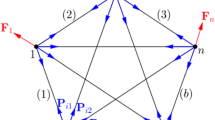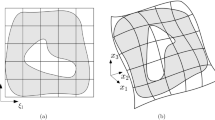Abstract
Mitchell proved that a necessary and sufficient condition for the existence of a topological hexahedral mesh constrained to a quadrilateral mesh on the sphere is that the constraining quadrilateral mesh contains an even number of elements. Mitchell’s proof depends on Smale’s theorem on the regularity of curves on compact manifolds. Although the question of the existence of constrained hexahedral meshes has been solved, the known solution is not easily programmable; indeed, there are cases, such as Schneider’s Pyramid, that are not easily solved. Eppstein later utilized portions of Mitchell’s existence proof to demonstrate that hexahedral mesh generation has linear complexity. In this paper, we demonstrate a constructive proof to the existence theorem for the sphere, as well as assign an upper-bound to the constant of the linear term in the asymptotic complexity measure provided by Eppstein. Our construction generates 76 × n hexahedra elements within the solid where n is the number of quadrilaterals on the boundary. The construction presented is used to solve some problems posed by Schneiders and Eppstein. We will also use the results provided in this paper, in conjunction with Mitchell’s Geode-Template, to create an alternative way of creating a constrained hexahedral mesh. The construction utilizing the Geode-Template requires 130 × n hexahedra, but will have fewer topological irregularities in the final mesh.














Similar content being viewed by others
Notes
Technically, the construction requires a Four-Split Quadrilateral Mesh with a ‘star-shaped’ boundary (i.e., there must be a point which can be seen by all nodes on the four-split boundary simultaneously).
Yamakawa and Shimada [11] provided an all positive Jacobian solution to Schneider’s Pyramid.
Mitchell S. to Shepherd J. email entitled ‘constructive approach to constrained hex mesh generation’, dated 31 March 2006.
Using Mitchell’s alternative Four-Split transition in the section titled An Alternative Four-Split Transition, the number of hexahedra required for the constrained solution is 54 × n (Fig. 11).
Using Mitchell’s alternative Four-Split transition in the section titled An Alternative Four-Split Transition, the number of hexahedra required for the constrained solution using the Geode-Template is 112 × n.
References
Bern MW, Eppstein D, Agarwal PK, Amenta N, Chew LP, Dey TK, Dobkin DP, Edelsbrunner H, Grimm C, Guibas LJ, Harer J, Hass J, Hicks A, Johnson CK, Lerman G, Letscher D, Plassmann PE, Sedgwick E, Snoeyink J, Weeks J, Yap C-K, Zorin D (1999) Emerging challenges in computational topology. ArXiv Computer Science e-prints, cs/9909001, pp 1–20
Carbonera CD, Shepherd JF (2006) On the existence of a perfect matching for 4-regular graphs derived from quadrilateral meshes. SCI Institute Technical Report, UUSCI-2006-021
Carbonera Pyramid. Available from http://www-users.informatik.rwth-aachen.de/∼roberts/SchPyr/index.html
Eppstein D (1996) Linear complexity hexahedral mesh generation. In: 12th ACM symposium on computational geometry. ACM, pp 58–67
Mitchell SA (1998) The all-hex geode-template for conforming a diced tetrahedral mesh to any diced hexahedral mesh. In: Proceedings, 7th international meshing roundtable. Sandia National Laboratories, pp 295–305
Mitchell SA (1996) A characterization of the quadrilateral meshes of a surface which admit a compatible hexahedral mesh of the enclosed volumes. In: 13th annual symposium on theoretical aspects of computer science, volume lecture notes in computer science. 1046:465–476
Mitchell SA, Tautges TJ (1995) Pillowing doublets: refining a mesh to ensure that faces share at most one edge. In: Proceedings, 4th international meshing roundtable. Sandia National Laboratories, pp 231–240
Murdoch PJ, Benzley SE (1995) The spatial twist continuum. In: Proceedings, 4th international meshing roundtable. Sandia National Laboratories, pp 243–251
Schneiders Pyramid open problem. Available at http://www-users.informatik.rwth-aachen.de/∼roberts/open.html
Suzuki T, Takahashi S, Shepherd JF (2005) Practical interior surface generation method for all-hexahedral meshing. In: Proceedings, 14th international meshing roundtable. Sandia National Laboratories, pp 377–397
Yamakawa S, Shimada K (2002) HEXHOOP: modular templates for converting a hex-dominant mesh to an ALL-hex mesh. Eng Comput (Lond) 18(3):211–228
Acknowledgments
The authors would like to express appreciation to Scott Mitchell for his review of the paper, and the many additional insights provided. We would also like to thank Cynthia Phillips, M. Gopi, and David Eppstein for their guidance and expertise in graph theory which enabled us to formulate a proof for perfect matching of closed quadrilateral meshes. Sandia is a multiprogram laboratory operated by Sandia Corporation, a Lockheed Martin Company, for the US Department of Energy’s National Nuclear Security Administration under contract DE-AC04-94AL85000.
Author information
Authors and Affiliations
Corresponding author
Rights and permissions
About this article
Cite this article
Carbonera, C.D., Shepherd, J.F. A constructive approach to constrained hexahedral mesh generation. Engineering with Computers 26, 341–350 (2010). https://doi.org/10.1007/s00366-009-0168-8
Received:
Accepted:
Published:
Issue Date:
DOI: https://doi.org/10.1007/s00366-009-0168-8




